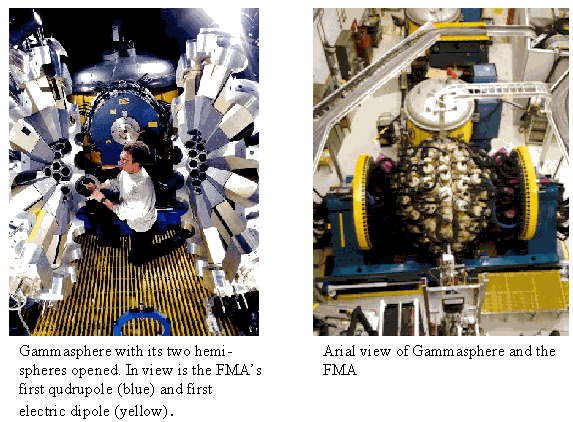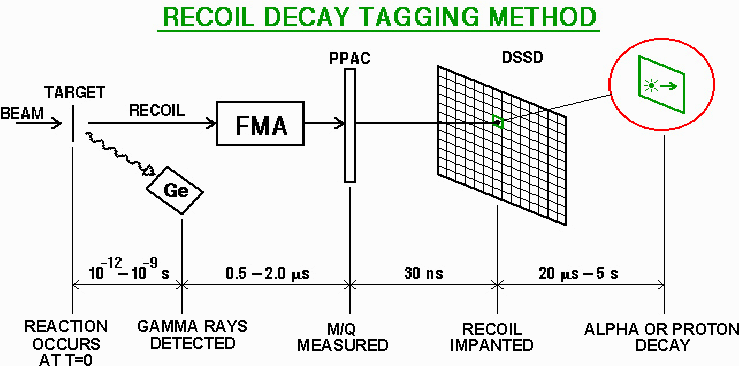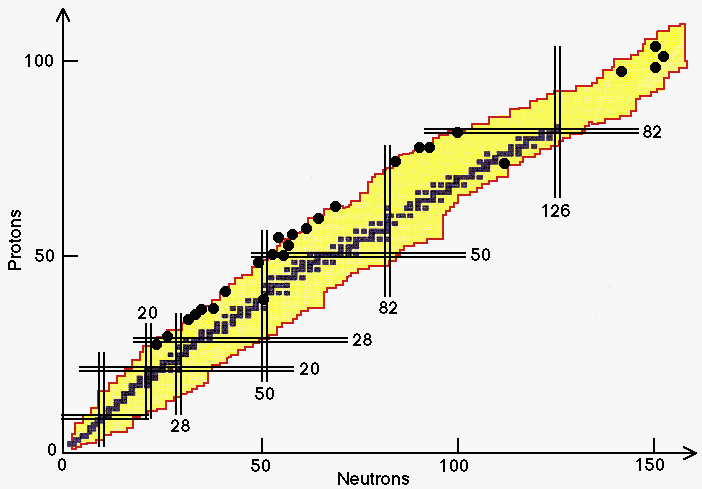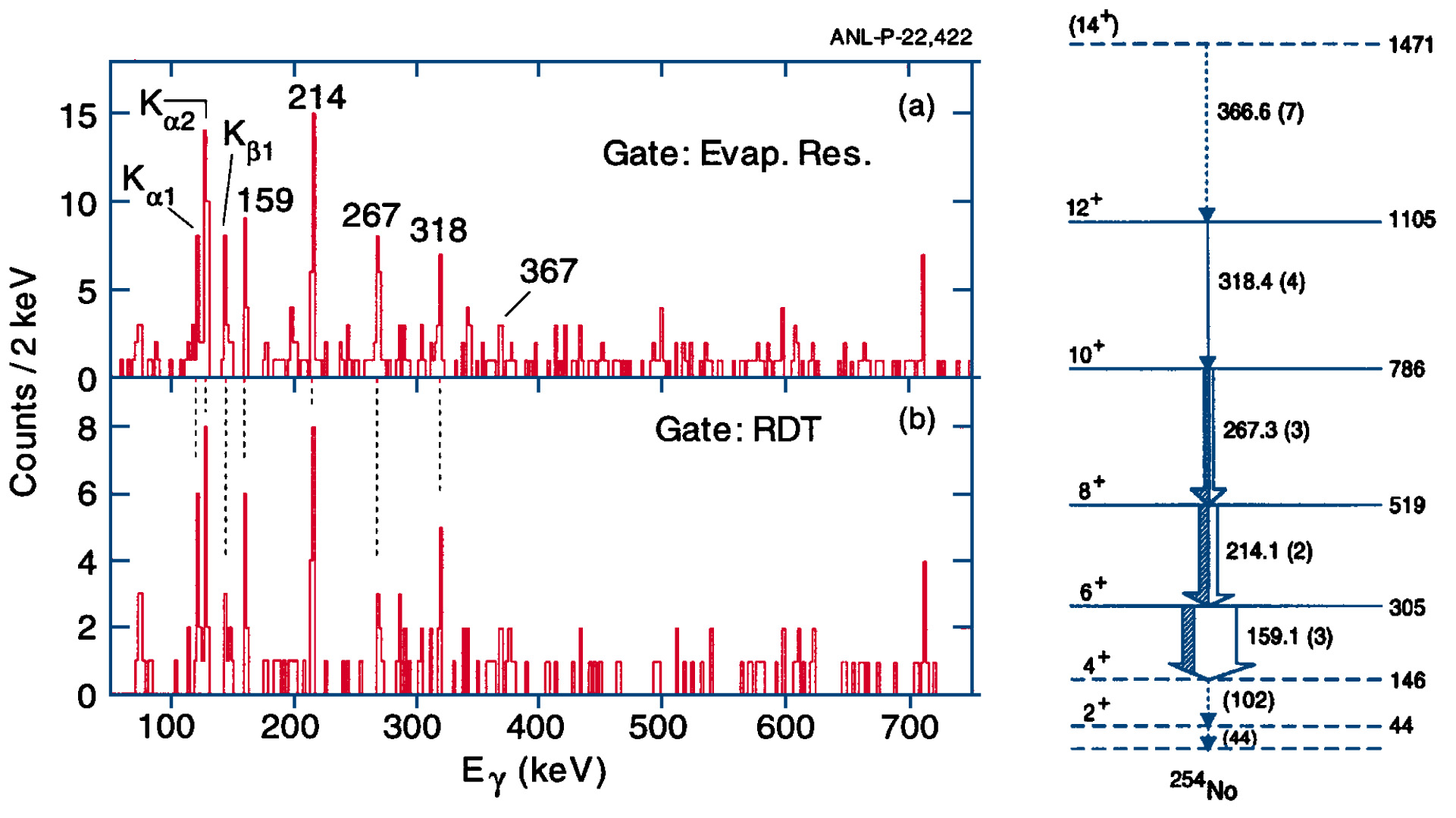PROBING EXCITED STATES IN NUCLEI
AT THE LIMITS OF STABILITY

1 Introduction
The study of nuclei far from stability has received much attention recently.
Indeed, the thrust of the next generation radioactive beam facilities will
be to study nuclei which lie at or near the neutron drip line. On the other
hand, nuclei which lie at the limits of proton excess have been produced
and identified for elements as heavy as Bismuth (Z=83). These isotopes
were initially characterized by their decay properties, and little, if
anything, was known about their excited states. A similar situation
exists for the heaviest elements (Z>100). Recently, with the coupling
of Gammasphere [LEE:90] to other detection systems, it has become
possible to identify gamma rays in nuclei lying
at and beyond the proton drip line and in the heaviest elements which are
often produced with cross sections as low as 100 nanobarn (nb). Consequentially,
studies of excited states in nuclei lying the furthest from stability have
begun.
2 Gammasphere at the FMA
Gammasphere is the
pre-eminent detector for gamma-ray spectroscopy studies in the world. The
device consists of up to 110 Compton-Suppressed Ge detectors, and it was
built by a collaboration of physicists from Argonne National Laboratory
(ANL) , Lawrence Berkeley National
Laboratory (LBNL)
, Oak Ridge National Laboratory (ORNL)
, and a number of U.S. universities. The device offers excellent energy
resolution (2.3 keV at 1 MeV) and an order of magnitude increase in photopeak
efficiency over previous Ge-arrays (~10% at 1 MeV). Between 1993-1997,
the device was sited at the 88"
Cyclotron Laboratory at LBNL where the major thrust of
the experimental program was directed at the study of high-spin states
in nuclei. A booklet summarizing the highlights of this first campaign
at Gammasphere can be found here.
In the fall of 1997, Gammasphere was moved to the ATLAS
accelerator at ANL and placed in front of the Fragment
Mass Analyzer (FMA) in order to shift the emphasis of the experimental
program from high-spin to nuclei far from stability. The FMA is a high
resolution mass spectrometer which transports reaction products produced
at the target position and disperses them by their mass/charge (M/Q) ratio
at the focal plane, 8.8 meters away [DAV:92]. Presently, two general techniques
are used at Gammasphere to make isotopic identification of weak channels
produced in fusion-evaporation reactions. The first involves the measurement
of evaporated particles, i.e. neutrons, protons, and/or alpha particles.
The number and type of particles measured give some degree of nuclide identification.
The second technique directly detects the residue, and nuclide identification
is made by measuring the properties of the residue, i.e. mass, energy,
time of flight and/or decay products. Experiments with the FMA utilize
this second technique.

Figure 1: Schematic
diagram of the Recoil Decay Tagging (RDT) Method as it is implemented at
ATLAS. The method allows for clean isotopic identification of gamma
rays detected at the target by correlating the implanted recoils with their
characteristic charged-particle radioactivity.
While the FMA coupled to Gammasphere allows for mass identification of
gamma rays, this is usually not sufficient for identifying the most proton-rich
isotopes. This is due to the fact that after the fusion of the projectile
and target, proton evaporation dominates over neutron evaporation in proton-rich
compound systems. Since neutron evaporation leads to the production of
systems lying furthest from stability, gamma rays emitted from nuclides
with the largest proton excess become completely obscured by the gamma
rays from the other isotopes produced in the heavy-ion reaction. Consequently,
isotopic identification becomes necessary for isolating gamma transitions
in these nuclei. With the FMA, this is achieved by placing ancillary
detectors behind the focal plane. For light and medium mass nuclei
(Z<50), it is possible to obtain isotopic selection by using
an ionization chamber. In heavier nuclei, isotopic identification
of gamma rays is made by correlating the characteristic charged-particle
radioactivity of an ion implanted in a pixel of a double-sided silicon
strip detector (DSSD) with a previously implanted recoil. Figure 1 shows
schematically how the technique works utilizing the DSSD setup at the FMA.
This technique has wide applicability due to the fact that above the closed
proton shell at Z=50, many nuclei near the proton-drip line decay
by the emission of an alpha particle, and beyond the drip line, odd-Z
nuclides are observed to decay by proton emission. This technique is referred
to as Recoil Decay Tagging (RDT) [PAU:95].

Figure 2: Known chart
of the nuclides. Black squares represent stable nuclei. Black circles represent
nuclei which have been measured with Gammasphere at ATLAS between
January, 1998 and September, 1998.
Experiments with Gammasphere coupled to the FMA were started in January,
1998. Figure 2 gives a summary of the Gammasphere experiments performed
thus far at ATLAS. As the figure clearly illustrates, most experiments
have been directed at nuclei far from stability, i.e. along the
proton-drip line or above Z=90.
3 Studies Beyond the Proton Drip Line
Above Z=50, the limits of proton excess are defined by the proton
emitters which have been identified in odd-Z nuclei up to Bismuth
(Z=83). These nuclei lie beyond the proton drip line (Qp
> 0) and are kept bound by the Coulomb force. A number of new proton
emitters have been identified recently using the FMA [DAV:97], and the
lifetimes in nearly all of these cases can be well reproduced by WKB calculations
using spectroscopic factors derived from spherical shell model calculations
This allows for definitive single-particle assignments to be given to the
proton-emitting states [DAV:97]. Recently, proton radioactivity has been
observed in 141Ho and 131Eu. However, the decay lifetimes
cannot be reproduced by WKB calculations , and this has been interpreted
as evidence for deformed grounds states in these nuclei [DAV:98].
By studying excited states built on top of these proton emitters, one should
be able to independently confirm both the deformation and single-particle
parentage of the proton-emitting state. This is especially critical for
the deformed emitters where there are only a few known cases. Other
questions which can be addressed by studying excited states in proton emitters
are:
-
Do present models whose parameters have been adjusted using stable nuclei
reproduce adequately nuclear structure all the way to the limits
of stability , including deformations, single-particle energies, and the
evolution of structure as a function of angular momentum?
-
How much excitation energy and angular momentum can these quasi-bound systems
accommodate?
-
Is there any evidence of mixing between bound and unbound states is these
loosely bound systems?
Experimentally, such studies are difficult because the cross-sections for
producing proton emitters are quite low (<100 microbarn). In addition,
the gamma-ray spectrum for an odd-A or odd-odd nucleus is in general more
complicated than that of even-even systems making gamma-ray coincidence
information necessary when determining the placement of even the first
few excited states in a proton emitter. With the coupling of Gammasphere
to the FMA , a 100 fold gain in gamma-gamma-recoil efficiency has been
realized over what was previously available. Thus, this opens up
the opportunity to perform gamma-ray coincidence measurements on proton-emitters.
Several such experiments have been peformed, and two of them are described
briefly below.
The two known alpha-emitting states in 167Ir were recently
found to proton decay [DAV:97]. Based on the partial half-lives,
the ground state was given an s1/2 assignment while the isomeric
state at 175 keV was assigned to the h11/2 configuration.
The spectroscopic factors deduced for these states agree with the low-seniority
shell model calculations which assume that all states are spherical.
In order to study excited states in 167Ir, gamma-recoil coincidences
were measured with Gammasphere and the FMA using a p,2n reaction
[CAR:98]. Figure 3a shows the gamma-ray spectrum correlated
with the alpha decay of the isomeric level in 167Ir utilizing
the RDT technique (fig. 2). These gamma rays are unresolvable in
the mass-gated spectrum due to the fact that the latter is dominated by
167Os (2p,n) and 167Re (3p)
gamma rays. The inset shows the partial level scheme deduced from
the gamma-ray coincidence data (all spins are tentative). A sequence
of gamma rays (672, 801, 865 keV) is observed to feed the isomeric
states. The pattern of excitation energy as a function of spin is
consistent with a spherical or weakly deformed structure, and is thus,
in agreement with the interpretation of the proton-decay data.

Figure 3: (Top) Gamma-ray spectrum correlated with
the alpha/proton decay of the h11/2 isomer state in 167Ir.
The inset shows the partial level structure built on top of the isomer.
(Bottom) Gamma-ray spectrum correlated with the ground-state proton decay
of 141Ho.
Recently, an experiment to measure excited states in 141Ho
was carried out with Gammasphere coupled to the FMA using the 92Mo(54Fe,p4n)
reaction [SEW:98]. Despite the fact that the production cross section for
141Ho is only 250 nb, gamma transitions in 141Ho
have been identified using the RDT technique. Fig. 3b shows the gamma-ray
spectrum correlated with 141Ho proton decays. If one assumes
that the transitions marked in the figure form a rotational band, the deformation
extracted from the bands moment of inertia agrees well with that deduced
from the proton-decay half-life [DAV:98]. However, due to low
statistics and lack of gamma-ray coincidence information, the grouping
of these transitions into a rotational sequence is tentative. Nevertheless,
the power of the technique to measure weakly populated channels is evident
and limited only by statistics at the 100 nb level.
4 Studies of the Heaviest Elements
Identification of new elements is an ongoing activity in nuclear physics.
Elements up to Z=112 have been identified by measuring the energy
of the alpha particle emitted when the nucleus decays and by correlating
it with the decay of a known daughter nucleus. Experimental quantities
extracted from heavy-element decay studies, i.e. alpha-decay energies
and alpha-decay lifetimes, can be reproduced by theoretical calculations
by assuming that these nuclei are deformed. A more direct determination
of the deformation can be obtained by measuring excited states in the nucleus
of interest. For heavy nuclei, this is extremely difficult due to
the fact that the production cross sections for very are at most a few
100 nb and typically much less. There is one exception to this: the
reaction using a 48Ca beam to bombard a 208Pb target
gives a maximum cross section of 3 microbarn for producing 254No
(Z=102) via the 2n channel.
Recently, a measurement was performed with Gammasphere in order to identify
excited states in 254No using this reaction [REI:99].
For this experiment, the FMA was essential to allow for the separation
of 254No residues from the fission background produced
at a 104 higher rate. Unambiguous identification of 254No
comes from the alpha-decay spectrum measured in the DSSD. The gamma-ray
spectrum obtained for 254No is shown in Fig. 4. These
transitions form a rotational band. Due to large conversion coefficients
for low energy transitions, it is most likely that the level fed by the
159 keV transition is not the ground state. In order to estimate
the spins of the levels connected by the observed transitions and the energies
of the missing transitions, the observed gama
rays have been fit using a rotational model. Following
this prescription, it was deduced that the 159 keV transition feeds the
6+ level, and the two missing transitions have energies
of 44 and 102 keV. The proposed level scheme with deduced spins is given
in Fig. 4, and it is consistent with a a rotational band with quadrupole
deformation estimated at 0.27 which agrees with the theoretical predictions.
An article in the January issue of Physical
Review Focus gives a more detailed discussion of this experiment.

Figure 4: 254No
spectra and deduced level structure. Panel (a) shows the gamma-ray spectrum
produced by gating on residues detected at the back of the FMA. Panel (b)
shows the gamma-ray spectrum produced by correlating gamma rays with the
alpha decay of 254No using Recoil Decay Tagging (RDT).
The RDT gated spectrum confirms the assignment of the gamma-ray observed
in (a) to 254No.
5. Summary
In the preceding sections experiments directed at the study excited states
in proton-emitters and heavy nuclei have been presented. A number of experiments
have also been performed with Gammasphere on proton drip line nuclei for
Z<50. In these medium mass nuclei between the closed proton shells
at Z=28 and Z=50, the proton drip line is approximated by
the N=Z line. Many of these experiments have utilized an array of
CsI detectors known as Microball
in order to make isotopic identification by detecting evaporated charged
particles. In some instances, an array of neutron detectors was also used.
Topics addressed in these experiments include the role of T=1 and T=0 neutron-proton
pairing in N=Z systems, astrophysical issues related to the R-P process,
proton
emission from excited non-isomeric states, and the study of excited
states in nuclei around 100Sn.
Studies of excited states in nuclei at the limits of stability with
a device such as Gammasphere are in their infancy. In many instances, only
a limited number of excited states have been placed, however, with the
refinement of techniques and the development of more efficient ancillary
detectors, a more complete understanding of these nuclei should become
available in the coming years.
References
[LEE:90] I.Y. Lee, Nucl. Phys. A520, 641 (1990).
[DAV:92] C.N. Davids et al., Nucl. Inst. Meth. Phys. Res. B70,
358 (1992).
[PAU:95] E.S. Paul et al., Phys. Rev. C 51, 78 (1995).
[CAR:98] M.P. Carpenter et al., in Proc. Conf. Nuclear Structure
'98, Gatlinburg, Tennessee, 1998, Vol. I, p. 13.
[SEW:98] D. Seweryniak, Bull. Am. Phys. Soc. 43, 1545 (1998).
[DAV:97] C.N. Davids et al., Phys. Rev. C 55, 2255 (1997).
[DAV:98] C.N. Davids et al., Phys. Rev. Lett. 80, 1849
(1998).
[REI:99] P. Reiter et al., Phys. Rev. Lett. 82, 509 (1999).





